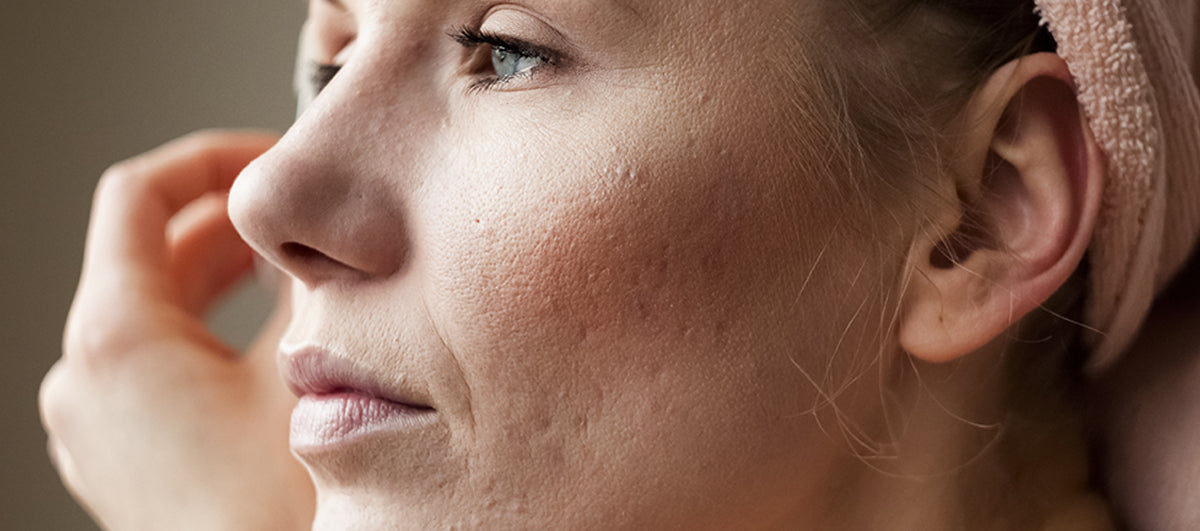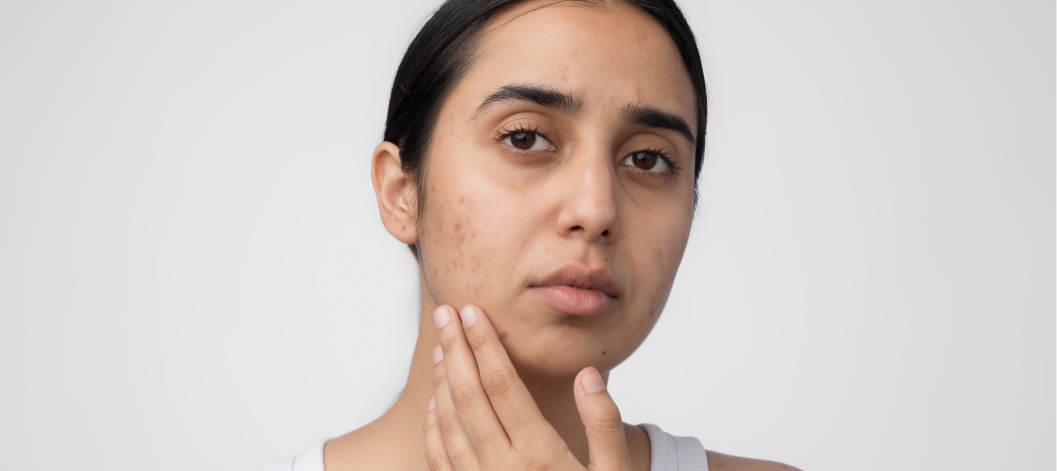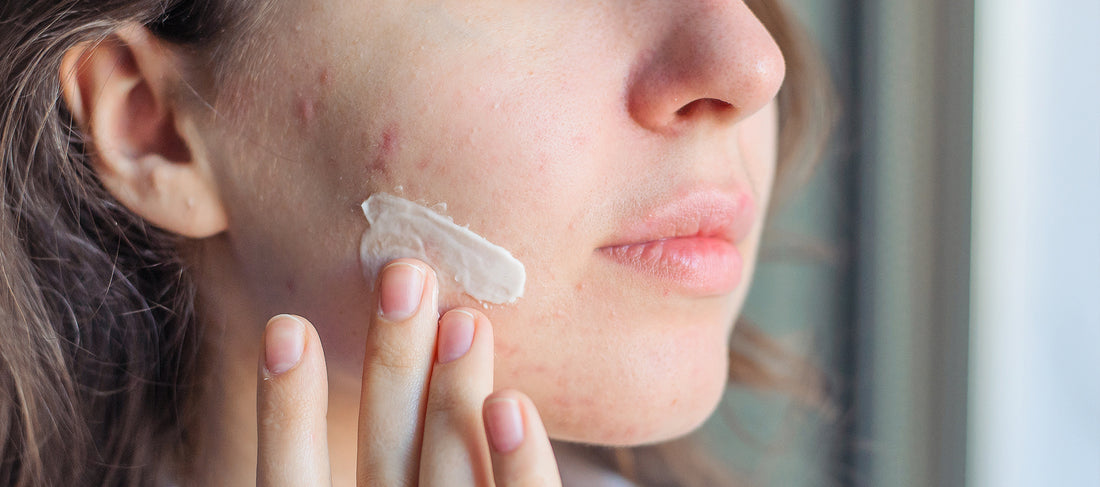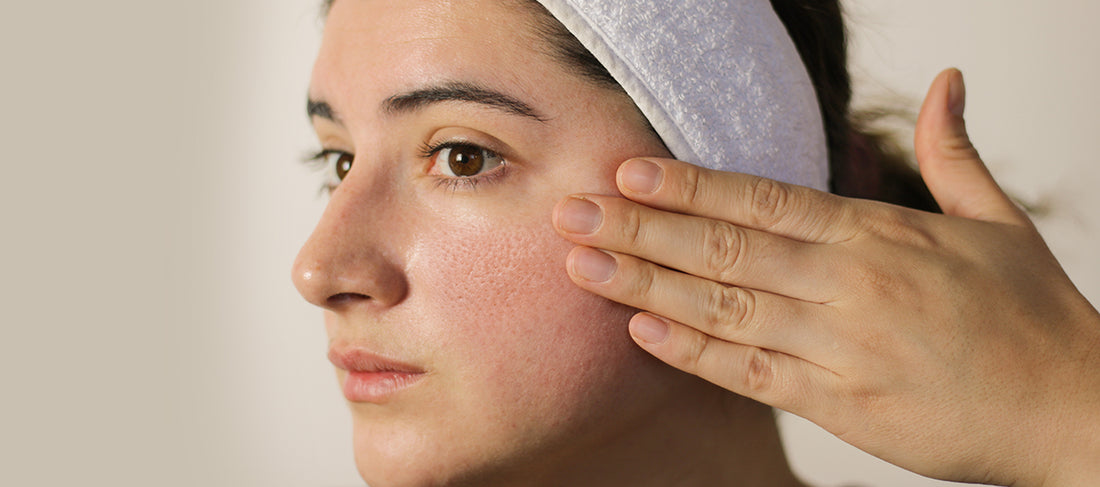Ever wonder why some skin concerns seem to stick around no matter what you do? Here's why:
Using the wrong skincare products, overdoing your routine, or simply lacking the right knowledge can make it hard to identify and address certain issues correctly.
Large pores and acne scars, for example, may look similar but require different treatments.
Choosing the wrong solution can lead to frustration and impact your skin health.
Read on to learn the difference between large pores and acne scars, and discover the best ways to treat them effectively.
What is the difference between large pores and acne scars?
The main difference between these skin woes is that large pores can likely cause acne scars due to excessive sebum (oil) production. On the other hand, acne scars cannot lead to large pores.

What are large pores?
Pores are small hair follicle openings that help to release body toxins through perspiration to keep your skin soft and supple.
But, when your pores appear larger than their original size, it may give rise to rough skin texture, blackheads, whiteheads, and inflamed acne.
Causes of large pores
- Excess sebum production
- Sun damage
- Lack of non-comedogenic skincare
- Reduces skin elasticity
- Thick hair follicles
Most effective ways to reduce enlarged pores
Minimizing large pores is the first step in preventing the next potential issue—acne scars. By addressing the problem early, you can avoid future complications.
That's why it's essential to incorporate the right skincare products into your routine to reduce pores and maintain healthy skin.
1. Prefer a gentle exfoliator
Regular exfoliation helps to prevent clogged pores, thereby reducing the chances of enlarged pores.
This process helps to clear the build of dead cells to keep your pores breathable and normal in size.
Additional benefits of exfoliation are - it boosts skin turnover to promote healthy and younger-looking skin.
Always consider using gentle exfoliators which do not harm your barrier layer while sloughing off dead skin cells.
Enzyme exfoliators work gently on all skin types to reveal brighter and smoother skin.
2. Opt for pore refining skin care products
Skincare formulations such as face toner and serums are specially designed to minimize enlarged pores and improve skin elasticity.
Toners
Toners help to deeply cleanse the pores and constrict their size after cleansing.
They work to remove impurities and traces of makeup left after cleansing.
Other incredible benefits of toners are that they balance out skin’s pH levels, remove excess sebum, and kill acne-causing bacteria in oily/acne-prone skin types.
A research study confirms the efficacy of botanical ingredients witch hazel, nasturtium officinale extract, aloe vera, seaweed, and lemon in minimising the appearance of pores.
Serums
Serums are specifically formulated to target individual skin concerns. They get absorbed quickly into the skin and deliver the actives effectively.
Face serums packed with niacinamide and hyaluronic acid really work well for enlarged pores and other signs of ageing.
Niacinamide helps to encourage the synthesis of ceramides to create a strong skin barrier.
While Hyaluronic Acid calms the inflammation and assists in the tissue regeneration process.
3. Wear sunscreen
Research says that unprotected sun exposure destroys the collagenand elastin protein in the skin which gives firmness and elasticity.
With the reduced skin elasticity, your pores begin to sag and stretch.
Wearing a broad spectrum sunscreen every day is one of the best preventive measures to protect your skin from sun damage and prevent your pores from getting larger.
Look for broad-spectrum sunscreen formulas with non-comedogenic properties to avoid clogging of pores.
What are acne scars?
Acne scars are characterized by deep and shallow depressions on your skin that generally come forth after a severe acne breakout infection.
Acne scars are formed when the deep, thick layer of skin i.e. dermis is damaged during acne infection.
In response to damage, your body starts making new collagen fibers (a naturally occurring protein) at the site of infection.
However, new skin tissue may have misaligned or imbalanced levels of collagen, which leads todifferent types of acne scars such as atrophic, hypertrophic, and icepick scars.
Causes of acne scars
- Inflammatory acne (acne cysts and nodules)
- Squeezing and scratching of pimples
- Pimples
- Delay in the treatment of inflammatory acne
Top ways to get rid of acne scars
To get rid of acne scars, dermatological procedures are plenty.
Luckily, there are also some topical ingredients for acne scars removal that you must consider.
Here are some of the ways you can get rid of acne scars -
1. Treat acne on time
Having said that, prevention is better than cure. Treating acne early may help to prevent scars.
A consistent acne skin care regimen along with anti-acne treatment speeds up acne recovery, hence preventing acne scars.
The key to healthy skin is not to leave any skin concern untreated and unaddressed.
2. Use topical acne scars treatments
Topical acne scar formulations comprising the potent botanical extract are identified as an excellent solution to get rid of acne scars and PIH (Post Inflammatory Hyperpigmentation).
It is considered one of the safest measures to help get rid of acne scars.
Such topical treatments can be available in the form of gels and serums to target individual skin concerns effectively.
Ingredients to look for in anti-acne scars formulations -
Allium Cepa Bulb Extract
It is one of the oldest cultivated species. This perennial plant is also known as Onion extract.
Research studies reveal its efficacy in reducing the appearance of acne scars and speeding up skin healing to restore the original structure of the skin damaged during acne infection.
It is a great source of bioflavonoids, like cephalin and kaempferol that help to diminish the inflammation of the scar area.
In addition, it also possesses anti-inflammatory properties.
Bulbine Frutescens Leaf Juice
It is another highly effective ingredient that accelerates the cell recovery process.
A research study published in The Journal of Ethnopharmacology elucidates that Bulbine frutescens extract promotes cutaneous wound healing.
It helps treat PIH. It helps in increasing tensile strength and increasing collagen deposition and maturation.
When formulated with Allium Cepa Bulb Extract, it helps heal scars and dark spots by stimulating skin regeneration and revitalization process.
Olea Europaea Leaf Extract (Olive)
The severity of your scar lies in how well and quickly the wound gets healed.
Olea Europaea Leaf Extract is a highly potent ingredient in healing acne scars.
It contains anti-acne properties that fight acne and prevent the formation of any new acne on the skin.
In addition, it has a high concentration of bioactive antioxidant and antibacterial compounds like Oleuropein, phenols, flavonoids, and vitamin C which promotes skin healing and skin regeneration.
Also, its high antibacterial properties work against acne-causing bacteria.
3. Microneedling
One of the treatments for fading away acne scars is microneedling. In this procedure, small needles are inserted into the skin to induce collagen production for scar healing.
However, this procedure has its own set of drawbacks and is often found to cause bruising, redness, and even inflammation of the skin.
Final takeaway
Treating your skin woes with precision and care while having a plan of action is imperative.
If you discover an unpleasant change on your skin, then do not jump to random solutions without attaining a thorough understanding of your concern.
Experts suggest identifying the root cause of your skin woes before chalking out a solution.
It will not only help you look after your skin correctly but also protect your skin from any impending damage.

















